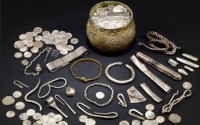The people behind the runes: Scandinavians in the British Isles
- Date
- 25 Apr 2017
- Start time
- 7:30 PM
- Venue
- Tempest Anderson Hall
- Speaker
- Prof Judith Jesch

The people behind the runes: Scandinavians in the British Isles
by Professor Judith Jesch, University of Nottingham
Joint lecture with York Museums Trust in celebration of its major 2017 exhibition ‘Beyond Jorvik: the Vale of York Hoard and the Viking World’
It has been said that the Vikings were ‘ruffians, but they were cultured ruffians’. They loved stories, poetry and art. And they were literate, at least in their alphabet of runes, which they used to inscribe short messages on a variety of objects. York, despite its rich Viking Age archaeology, has not yet turned up any runic inscriptions. But from Canterbury in the south to Shetland in the north, Scandinavians left behind runic inscriptions across Britain and these will be the subject of the lecture. While such inscriptions are few, and many of them appear at first glance to say very little, we can still learn a lot about the individuals who made them by examining the texts and objects closely: their names, gender and status, the language(s) they spoke, their interests and their religion. The Scandinavian runic inscriptions of Britain provide a new and unusual perspective on the Viking Age.
Member’s report
Runes are an alphabet, in use in four different versions, from around 150-1450 AD. They were used mainly in Scandinavia, and wherever the Vikings had influence: from Greenland across northern Europe and into Russia, though there are even some in in Hagia Sofia, Istanbul. Consisting of simple lines, without curves, they are readily carved on stone or wood. About 7000 runic inscriptions have been found in the British Isles, mostly in Ireland, and the North and West of Britain – including Orkney and the Isle of Man, though surprisingly few if any have (yet) been found in Yorkshire, this most Viking-influenced of regions. They appear on memorial stones, and on surviving pieces of wood; using Old Norse, Old English and even Latin. They hint at stories; convey poetic, or cryptic messages (twitter-like?); offer conventional greetings; or just sexual boasts – as in graffiti inside Maes Howe on Orkney. Some contain Celtic as well as Scandinavian names, and together with linguistic usages suggests growing cultural assimilation and integration.
Carole Smith